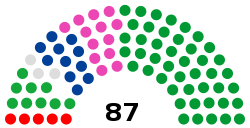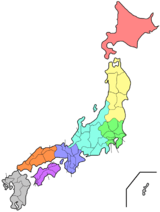Hyogo Prefectural Assembly
The Hyogo Prefectural Assembly (兵庫県議会, Hyōgo-ken gikai) is the prefectural parliament of Hyogo Prefecture.
Hyogo Prefectural Assembly 兵庫県議会 Hyōgo-ken Gikai | |
|---|---|
 | |
| Type | |
| Type | |
| History | |
| Founded | May 15, 1879[1] |
| Leadership | |
Speaker (gichō) | |
Vice Speaker (fuku-gichō) | |
| Structure | |
| Seats | 87 assembly members from 40 electorates[4] |
 | |
| Committees | Standing committees: General Affairs; Health & Welfare, Industry, Employment & International Affairs; Agricultural & Environmental Affairs; Constitution; Education; Police[1] |
| Committees | Special committees: Budgetary Estimates; Accounting; Administrative Reform; Electoral Reform[5] |
| Elections | |
| Single non-transferable vote | |
Last election | 12 April 2015 (2015 unified local elections) |
| Meeting place | |
| Website | |
| www | |
The assembly's 87 members are elected every four years in 40 districts by single non-transferable vote. Nine of the electoral districts correspond with the wards of Kobe city and the remaining 31 districts are made up of the cities and districts (towns and villages) of the prefecture. The electoral district that represents the city of Himeji is the largest, electing 8 representatives to the assembly.[4]
The assembly is responsible for acting as a balance against the Governor of Hyogo Prefecture who is responsible for the administration of the prefecture. This role includes enacting and amending prefectural ordinances, approving the budget and checking the administration.[6]
Current composition
The 2015 Hyogo prefectural election took place on 12 April 2015, as part of the 2015 unified local elections. It was the first election following a reduction in the number of members from 89 to 87. Elections were held in 23 districts and representatives for the remaining 17 districts were elected unopposed.[7] The Liberal Democratic Party (LDP) maintained their position as the largest group in the assembly with a total of 40 seats (official candidates plus independents endorsed by the party), but were unable to secure the 44 seats required for an outright majority. The Democratic Party of Japan (DPJ) was reduced from 16 seats to 11. The Japan Innovation Party, contesting the unified local elections for the first time, won nine seats.[8] Voter turnout was 40.55%, a reduction of 0.88% compared to the 2011 election.[9] Following the election, the LDP's Noriyuki Ishikawa and Ryosuke Ueda were elected speaker and vice-speaker of the assembly.[3]
As of February 2016, the assembly was composed as follows:[10]
| Composition of the Hyogo Prefectural Assembly | |
|---|---|
| Parliamentary group | Seats |
| Liberal Democrats | 45 |
| Komeitō | 13 |
| Democratic Party of Japan | 11 |
| Japan Innovation Party | 9 |
| Japanese Communist Party | 5 |
| Independents | 3 |
| Total | 87 |
Electoral districts
Most electoral districts correspond to the current cities of the prefecture, but several districts correspond to former districts which are no longer administrative units but are still used in the addresses of regional areas. Kobe, the largest city in the prefecture, is divided such that each of the city's nine wards is a separate electoral district.[4] In 2014 the assembly voted to reduce the size of the assembly from 89 to 87, which resulted in a merger of the Sayō and Akō-Akō districts, as well as Takasago district's representation being reduced from two members to one.
| Electoral districts[4] | |||||
|---|---|---|---|---|---|
| District | Municipalities | Magnitude | District | Municipalities | Magnitude |
| Higashinada | Higashinada ward, Kobe | 3 | Akō-Akō-Sayō | Akō city Kamigōri town Sayō town | 1 |
| Nada | Nada ward, Kobe | 2 | Nishiwaki and Taka | Nishiwaki city Taka town | 1 |
| Chūō | Chūō ward, Kobe | 2 | Takarazuka | Takarazuka city | 3 |
| Hyōgo | Hyōgo ward, Kobe | 2 | Miki | Miki city | 1 |
| Kita | Kita ward, Kobe | 3 | Takasago | Takasago city | 1 |
| Nagata | Nagata ward, Kobe | 2 | Kawanishi-Kawabe | Kawanishi city Imagawa town | 3 |
| Suma | Suma ward, Kobe | 3 | Ono | Ono city | 1 |
| Tarumi | Tarumi ward, Kobe | 3 | Sanda | Sanda city | 2 |
| Nishi | Nishi ward, Kobe | 3 | Kasai | Kasai city | 1 |
| Himeji | Himeji city | 8 | Sasayama | Sasayama city | 1 |
| Amagasaki | Amagasaki city | 7 | Yabu | Yabu city | 1 |
| Akashi | Akashi city | 4 | Tanba | Tanba city | 1 |
| Nishinomiya | Nishinomiya city | 7 | Minamiawaji | Minamiawaji city | 1 |
| Sumoto | Sumoto city | 1 | Asago | Asago city | 1 |
| Ashiya | Ashiya city | 1 | Awaji | Awaji city | 1 |
| Itami | Itami city | 3 | Shisō | Shisō city | 1 |
| Aioi | Aioi city | 1 | Katō | Katō city | 1 |
| Toyooka | Toyooka city | 1 | Kako | Harima town Inami town | 1 |
| Kakogawa | Kakogawa city | 4 | Kanzaki | Kukusaki town Ichikawa town Kamikawa town | 1 |
| Tatsuno-Ibo | Tatsuno city Taishi town | 2 | Mikata | Kami town Shinonsen town | 1 |
References
- "Hyogo Prefectural Assembly" (PDF). Retrieved 23 February 2016.
- "兵庫県議会-議長・副議長のページ" [Hyogo prefectural Assembly - Chairman and Deputy Chairman's Page] (in Japanese). Retrieved 23 February 2016.
- "兵庫県議会・正副議長 自民が独占維持 4会派共闘もとどかず" [LDP retain Hyogo Assembly chair and deputy, 4-party united challenge unsuccessful] (in Japanese). Kobe Shimbun. 12 June 2015. Retrieved 23 February 2016.
- "県議会議員の概要" [Outline of Assembly Members] (in Japanese). Archived from the original on 2 July 2017. Retrieved 23 February 2016.
- "特別委員会" [Special committees]. Retrieved 23 February 2016.
- "県議会まめ知識" [Assembly Trivia] (in Japanese). Retrieved 23 February 2016.
- "兵庫県議選得票率 自民と民主は減、維新10%超に" [Hyogo Prefectural Election Vote Percentages: LDP and DPJ down, Innovation exceeds 10%] (in Japanese). Kobe Shimbun. 14 April 2015. Retrieved 23 February 2016.
- "兵庫県議選各党派分析 民主5減、公明と共産は維持" [Analysis of Hyogo Prefectural Election Party Results: DPJ down 5, Komeito and Communists steady] (in Japanese). Kobe Shimbun. 13 April 2015. Retrieved 23 February 2016.
- "兵庫県議選 歯止めかからぬ投票率低下 10選挙区は上昇" [Hyogo Assembly Election: Brakes not stopping reduction in turnout -- increase in 10 districts]. Kobe Shimbun. 13 April 2015. Retrieved 23 February 2016.
- "議員紹介/会派別一覧表" [List of Assembly Members by Party] (in Japanese). Retrieved 23 February 2016.
External links
- Hyogo Prefectural Assembly (in Japanese)
